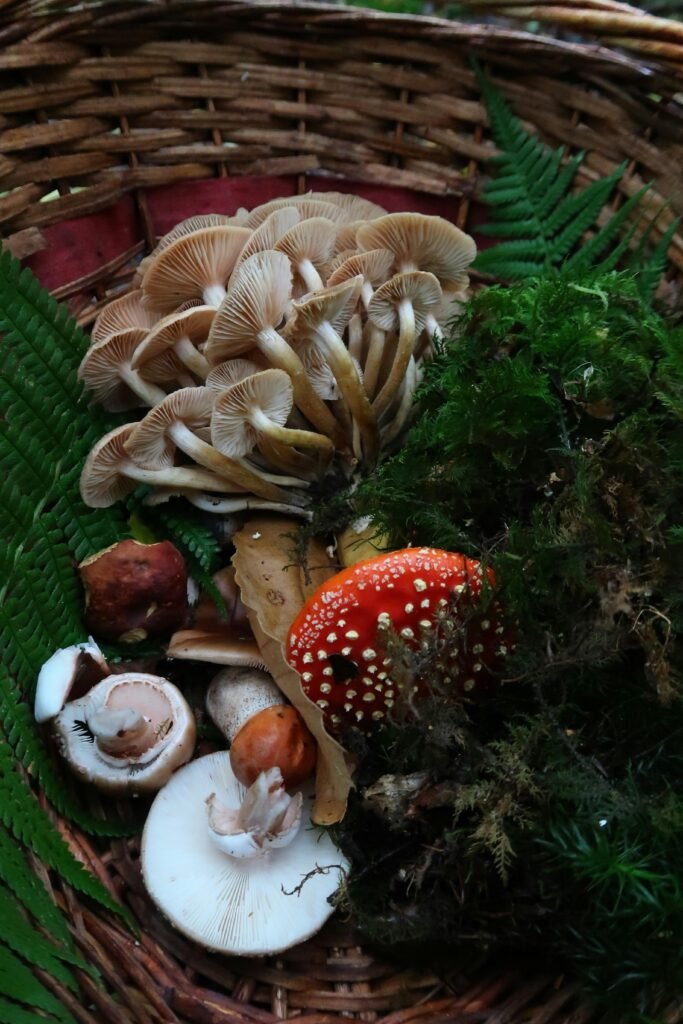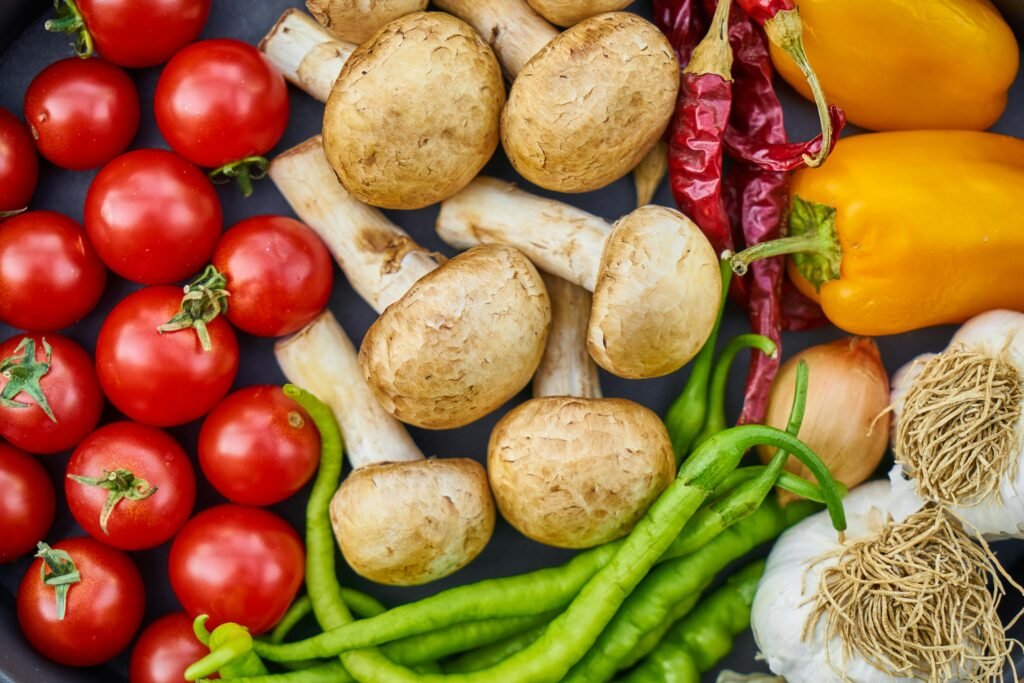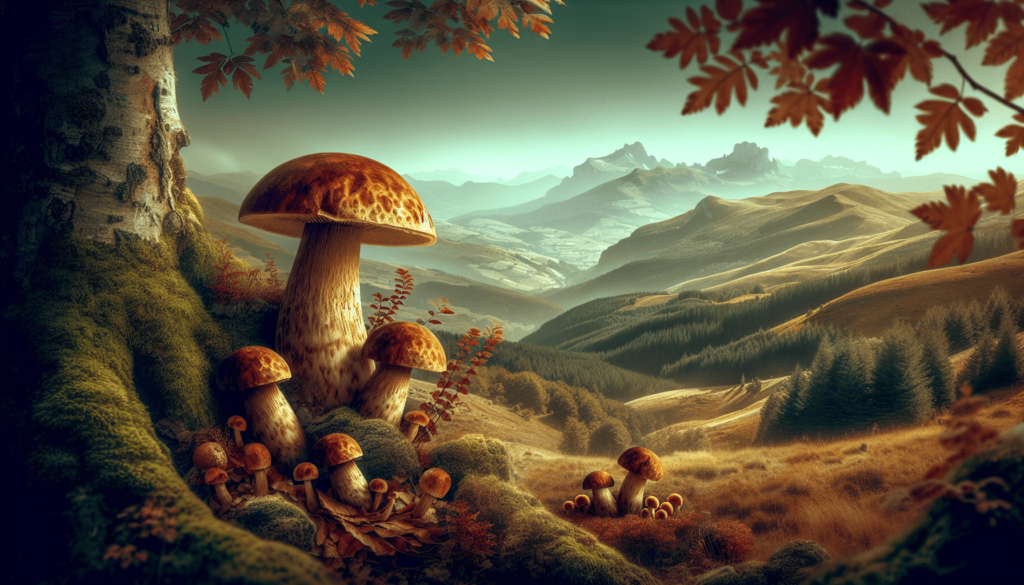Embark on a fascinating journey through the enchanting and bountiful world of mushroom foraging in the Pyrenees with “A Forager’s Guide to the Pyrenees’ Mushroom Seasons.” This captivating article offers readers a comprehensive exploration of the region’s diverse mushroom seasons, from the tantalizing truffles of winter to the vibrant chanterelles of autumn. Immerse yourself in the ecological and climatic conditions that make the Pyrenees a paradise for mushroom enthusiasts, while gaining valuable insights into foraging techniques, culinary and medicinal uses, and the importance of conservation. With engaging narratives and personal stories, this article invites you to embrace the art and science of mushroom foraging, igniting your sense of wonder and curiosity for these hidden treasures of nature.

Introduction to the Pyrenees
Welcome to the beautiful Pyrenees! Nestled between Spain and France, this mountain range offers a breathtaking landscape and a rich diversity of flora and fauna. In this comprehensive guide, we will explore the mushroom seasons in the Pyrenees, the types of mushrooms you can find here, the best foraging locations, the optimal times to forage, safety and ethics of foraging, foraging techniques and tools, culinary uses of Pyrenees mushrooms, their medicinal properties, and the vibrant mushroom foraging community in the region.
Geographical Overview
The Pyrenees stretch approximately 430 kilometers from the Mediterranean Sea to the Bay of Biscay. This majestic mountain range is home to countless valleys, peaks, meadows, and forests, creating a diverse and favorable environment for mushroom growth. The Pyrenees are divided into three regions: the Atlantic Pyrenees, the Central Pyrenees, and the Eastern Pyrenees. Each region has its own unique characteristics and mushroom varieties.
Climatic Conditions
The Pyrenees experience a varied climate due to their geographical location and diverse topography. In general, the climate is influenced by both Mediterranean and Atlantic weather patterns. The lower elevations tend to have a Mediterranean climate, characterized by hot summers and mild winters, while the higher altitudes have a cooler and wetter climate. This combination of microclimates throughout the Pyrenees contributes to the abundance of mushrooms in the region.
Mushroom Season in the Pyrenees
The mushroom season in the Pyrenees is a much-anticipated time for foragers and nature enthusiasts. It typically spans from late spring to early winter, with each season offering different mushroom species to discover and enjoy. Let’s take a closer look at each season and the mushrooms you can expect to find.
Spring Season
As the snow melts and the temperature rises, the forests of the Pyrenees come alive with the first signs of mushroom growth. Spring is a wonderful time for foragers, as various species start to emerge from the forest floor. One of the most prized mushrooms during this season is the Morel (Morchella), known for its distinctive honeycomb-like cap. Other mushrooms that can be found in the spring include the St. George’s Mushroom (Calocybe gambosa) and the Oyster Mushroom (Pleurotus ostreatus).
Summer Season
Summer in the Pyrenees brings warmer temperatures and intermittent rainfall, creating the perfect conditions for an abundance of mushrooms. Boletus Edulis, also known as the Porcini or Cep, is one of the most sought-after mushrooms during this season. Its meaty texture and earthy flavor make it a favorite among mushroom enthusiasts. Chanterelles (Cantharellus cibarius) also make their appearance, with their vibrant yellow color and delicate, fruity aroma.
Autumn Season
Autumn is considered the prime time for mushroom foraging in the Pyrenees. The cooler temperatures and increased rainfall create an ideal environment for an array of mushroom species. The Amanita Caesarea, or the Caesar’s Mushroom, steals the spotlight during this season. This bright orange mushroom with its distinctive white flecks is highly valued for its delicious flavor and culinary versatility. Another popular mushroom during autumn is the Lactarius deliciosus, commonly known as the Saffron Milk Cap. Its vibrant orange color and saffron-like aroma make it a delightful addition to any dish.
Winter Season
While the colder and snowier winter season may seem inhospitable for mushroom foraging, there are still opportunities to find certain mushroom species. The Wood Blewit (Lepista nuda) is known to withstand the chilly temperatures and can often be found during this time. It has a unique purple hue and a mild, nutty flavor. Winter foraging requires additional knowledge and caution, as the mushrooms that grow during this season may have similar appearances to toxic varieties.

Types of Mushrooms in the Pyrenees
The Pyrenees boast a diverse range of mushroom species, each with its own distinctive characteristics and culinary uses. Let’s explore some of the most notable mushrooms found in this region.
Boletus Edulis
Boletus Edulis, also known as the Porcini or Cep, is a highly revered mushroom in the culinary world. With its meaty texture and rich, earthy flavor, it is a favorite among chefs and food enthusiasts. Boletus Edulis can be found in the Pyrenees during the summer and autumn seasons, usually near pine and oak trees.
Cantharellus Cibarius
The golden treasure of the Pyrenees, Cantharellus Cibarius, commonly known as the Chanterelle, is a coveted mushroom among foragers. Its vibrant yellow color, trumpet-like shape, and delicate, fruity aroma make it a culinary delight. Cantharellus Cibarius can be found in the Pyrenees during the summer and autumn seasons, often in mossy and damp areas.
Amanita Caesarea
Amanita Caesarea, or the Caesar’s Mushroom, is a regal and highly sought-after mushroom in the Pyrenees. Its bright orange cap adorned with white flecks makes it easily distinguishable from other mushrooms. With its delicious flavor and versatility in cooking, the Amanita Caesarea is a prized find during the autumn season. It can often be found in association with oak and pine trees.
Lactarius Deliciosus
Lactarius Deliciosus, commonly known as the Saffron Milk Cap, is a vibrant orange mushroom that adds a burst of color and flavor to any dish. Its unique saffron-like aroma and mildly peppery taste make it a popular choice among foragers and chefs. Lactarius Deliciosus can be found in the Pyrenees during the autumn season, usually in pine and oak forests.
Foraging Locations in the Pyrenees
The Pyrenees offer a plethora of prime foraging locations for mushroom enthusiasts. From national parks and reserves to mountainous areas and woodlands, let’s explore the different habitats where you can embark on your mushroom foraging adventures.
National Parks and Reserves
The Pyrenees are blessed with several national parks and nature reserves that provide ideal conditions for mushroom growth. One such park is the Ordesa and Monte Perdido National Park, located in the Central Pyrenees. Its diverse ecosystem, ranging from lush forests to high mountain peaks, offers an incredible variety of mushrooms waiting to be discovered. The Aigüestortes i Estany de Sant Maurici National Park, in the Eastern Pyrenees, is another excellent foraging location renowned for its rich mycological biodiversity.
Mountainous Areas
The mountainous areas of the Pyrenees are a treasure trove for mushroom foragers. With their higher elevation, these areas offer unique microclimates and a variety of mushroom species. The Pyrenees mountain range itself provides numerous opportunities for foraging, especially during the summer and autumn seasons. Exploring trails and paths in the mountains can lead to exciting mushroom discoveries.
Woodland and Forests
The woodlands and forests of the Pyrenees are teeming with mushrooms throughout the year. From dense beech forests to enchanting oak and pine woods, these habitats create an ideal environment for fungi. Exploring woodland areas, paying attention to fallen logs and the forest floor, can reveal an array of mushroom species awaiting discovery. The Val d’Aran, a stunning valley in the Atlantic Pyrenees, is known for its diverse forests and is a popular location for mushroom foraging.

Best Times to Forage
To make the most of your mushroom foraging experience in the Pyrenees, it’s important to understand the optimal conditions and peak seasons for different mushroom species.
Optimal Conditions
Mushrooms thrive in specific environmental conditions. Generally, the best time to forage is after rainfall, as moisture is crucial for mushroom growth. Mild temperatures and a damp forest floor are also favorable conditions for mushroom emergence. Additionally, it’s important to plan your foraging expedition during the right season for your target mushroom species.
Peak Seasons for Different Species
Each mushroom species has its own peak season when it is most abundant. The Morel mushrooms can be found in the Pyrenees in the spring, while Boletus Edulis and Chanterelles are prominent during the summer and autumn months. Amanita Caesarea and Lactarius Deliciosus are most commonly found in the Pyrenees during the autumn season. Winter foraging requires specialized knowledge and caution, as there are fewer edible species during the colder months.
Safety and Ethics of Foraging in the Pyrenees
Foraging in the Pyrenees is an enjoyable and rewarding experience, but it is essential to prioritize safety and ethics. Here are some key considerations when engaging in mushroom foraging in this region.
Identification and Toxicity
One of the most crucial aspects of mushroom foraging is accurate identification. Misidentification can have serious consequences, as some mushrooms are highly toxic or even deadly. It is essential to learn how to correctly identify edible mushrooms and be cautious when uncertain. Consulting field guides, joining foraging groups, or learning from experienced local experts can greatly enhance your knowledge and confidence in identifying mushrooms.
Permission and Regulations
Respecting the rules and regulations of the areas where you plan to forage is vital. Some national parks and nature reserves may have specific guidelines regarding foraging activities. Researching and obtaining any necessary permits or permissions beforehand helps ensure compliance with local regulations. It’s also important to be mindful of private property boundaries and obtain permission from landowners when necessary.
Conservation Practices
Practicing conservation and sustainability is essential to preserve the biodiversity of the Pyrenees and maintain the health of ecosystems. Avoid overharvesting or damaging mushrooms and their habitats. Leave no trace by being careful not to disturb the forest floor or surrounding vegetation. By practicing responsible foraging, we can contribute to the long-term sustainability of mushroom populations in the Pyrenees.

Foraging Techniques and Tools in the Pyrenees
Equipping yourself with the right techniques and tools can greatly enhance your mushroom foraging experience in the Pyrenees. Here are some essential tips to help you on your foraging journey.
Equipment and Gear
Carrying the appropriate equipment and gear is crucial for a successful foraging trip. Essential items include a sturdy basket or bag to collect mushrooms, a knife for careful harvesting, a field guide or smartphone app for identification purposes, and protective clothing such as gloves and a hat. It’s also advisable to bring a small brush or mushroom brush to gently clean the harvested mushrooms.
Identifying Edible Mushrooms
Learning the characteristics and identification features of edible mushrooms is essential for safe foraging. Take the time to familiarize yourself with the distinct traits of the mushrooms you intend to collect. Pay attention to factors such as cap shape, color, stem structure, spore color, and the presence or absence of certain features like gills or pores. When in doubt, consult reliable field guides or seek guidance from experienced foragers or mycologists.
Harvesting Methods
Harvesting mushrooms requires care and precision to ensure the health of the fungal organism and the surrounding ecosystem. When harvesting, gently cut or twist the mushroom at the base of the stem, leaving the mycelium intact. Avoid pulling or uprooting the mushroom, as this can harm the mycelial network underground. Dispose of any non-edible or toxic mushrooms responsibly to prevent accidental ingestion by others or animals.
Culinary Uses of Pyrenees Mushrooms
The Pyrenees region is not only a paradise for mushroom foragers but also a culinary delight. The mushrooms found in this region have been cherished for their unique flavors and culinary applications for centuries. Here are some traditional recipes and local culinary delights featuring Pyrenees mushrooms.
Traditional Recipes
The Pyrenees region boasts a rich culinary heritage when it comes to mushrooms. From hearty stews and soups to savory tarts and risottos, mushrooms are commonly used in traditional recipes that showcase their natural flavors. One popular dish is the Spanish Revuelto de Setas, a delectable scrambled egg dish featuring sautéed mushrooms. Another traditional recipe is the French Pieds de Mouton en Persillade, which combines wild mushrooms with garlic, parsley, and butter for a simple yet flavorful side dish.
Local Culinary Delights
The local cuisine influenced by the Pyrenees’ mushroom bounty often features dishes that highlight the unique flavors of the region. Many restaurants and eateries offer mushroom-themed menus during the peak seasons, allowing visitors to savor the freshest mushrooms. From mushroom tapas to mushroom-infused sauces and creams, the Pyrenees’ culinary scene celebrates the gastronomic wonders of these foraged treasures.

Medicinal Properties of Pyrenees Mushrooms
Beyond their culinary applications, Pyrenees mushrooms have long been valued for their medicinal properties. Traditional healing practices and knowledge passed down through generations recognize the therapeutic benefits of certain mushroom species. Here are some notable examples:
Healing Traditions
In the Pyrenees, mushrooms have been used for centuries as natural remedies. Traditional healing practices incorporate mushrooms for their immune-boosting, anti-inflammatory, and antioxidant properties. Fungi such as the Reishi Mushroom (Ganoderma lucidum) and the Turkey Tail Mushroom (Trametes versicolor) are highly regarded for their potential health benefits and are often consumed in the form of teas, tinctures, or extracts.
Health Benefits
Pyrenees mushrooms offer a wide range of potential health benefits. Some species, like the Chaga Mushroom (Inonotus obliquus), are known for their high antioxidant properties, which can help combat free radicals and support overall well-being. Others, such as the Lion’s Mane Mushroom (Hericium erinaceus), are thought to support cognitive function and promote nerve regeneration. Before using mushrooms for medicinal purposes, it is essential to consult with a healthcare professional or herbalist.
Mushroom Foraging Community in the Pyrenees
The Pyrenees have a vibrant and passionate mushroom foraging community that brings together enthusiasts, experts, and locals. Being part of this community provides opportunities for learning, sharing experiences, and fostering a sense of belonging. Let’s explore some aspects of the mushroom foraging community in the Pyrenees.
Foraging Groups and Events
Foraging groups and associations are an excellent way to connect with other mushroom enthusiasts in the Pyrenees. These groups organize forays, expeditions, and events dedicated to mushroom foraging. Joining a foraging group provides opportunities to learn from experienced foragers, share knowledge, and collectively explore the world of mushrooms in the Pyrenees.
Local Experts and Gatherings
The Pyrenees are home to numerous local experts, mycologists, and researchers who have dedicated their lives to the study of mushrooms. Attending gatherings, workshops, or conferences hosted by these experts offers valuable insights into the local mushroom species, their ecological importance, and their cultural significance. These events are also a great platform for networking and building connections within the mushroom foraging community.
In conclusion, the Pyrenees offer a treasure trove of mushrooms waiting to be discovered. With its diverse ecosystems, unique microclimates, and passionate foraging community, the region provides an ideal environment for both novice and seasoned mushroom enthusiasts. Embrace the adventure, explore the natural wonders of the Pyrenees, and embark on a magical journey of mushroom foraging. Remember to forage responsibly, respect nature, and savor the culinary and medicinal delights that these fungi have to offer. Happy foraging in the Pyrenees!
